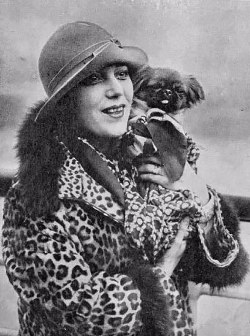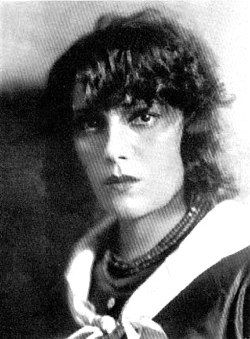Raquel Meller | home 
INTRO | PROFILE | BIOGRAPHY | DISCOGRAPHY | CDs | FILMOGRAPHY | GALLERY | MEMORABILIA | BIBLIOGRAPHY | LINKS
BIOGRAPHY
Raquel Meller
by Mark O. Martinez
Copyright 2012, 2019 Miami, FL USA
LA BELLA RAQUEL
Singer-actress Raquel Meller was one of the most popular and celebrated women of the 20th century. She was born into a very poor family in Tarazona, province of Aragón, in Spain on March 9, 1888 and was christened the following day as Francisca Marqués López. Not much is known about her early years but, as a child, her parents placed her at a convent in Tudela since they couldn´t care for her. Later an aunt who was a nun in Figueres claimed the girl and became her legal guardian.
Francisca, along with other poor girls growing up in the cloister, received some basic general education as well as training in cooking, housekeeping, sewing, embroidery, etc. By all accounts Francisca was a good student and particularly loved sewing as well as singing in the choir though it became obvious that she was not convent material. The girl had an independent, strong personality and little patience when things didn’t go her way.
At age 12 she went back to her family who was then residing in Barcelona as poor as ever. It has been reported that she had to share the humble living quarters with seven brothers and one sister so it is not surprising that by age 13 Francisca was working as a seamtress at a local shop. One of the clients, singer Marta Oliver overheard Francisca humming a tune while sewing and asked her if she was interested in singing professionally. The teenager jumped at the opportunity and, according to the official story, she made her debut at a small music hall named La Gran Peña in 1907 wearing a dress borrowed from Miss Oliver. However, there's evidence that as early as 1906, she was entertaining in trashy little joints as a "cupletista" or couplet singer, sometimes performing in duets with her younger sister Tina. Couplets were short songs imported from France which were given Spanish lyrics full of sex references, double meanings and sometimes even social commentary.
|
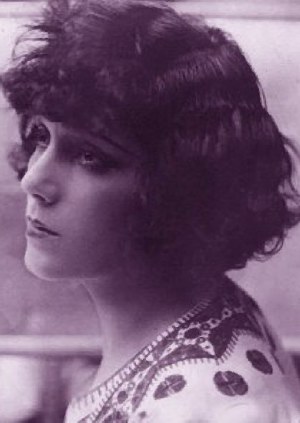 Francisca Marqués López,
better known as RAQUEL MELLER
|
As a rule they were performed by young females trying to escape poverty in modest bistros which catered to all-male audiences. Consequently, in music circles the couplet, which in Spanish became "cuplé," was considered "a degraded genre" lacking musical merit and respectability, more so when the performers were expected to socialize with the public between shows, a practice that encouraged rampant prostitution. As a solo act, Francisca became known as La Bella Raquel but nobody knows the source of the name.
|
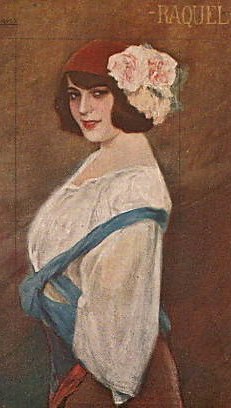 An early portrait by Carlos Vázquez
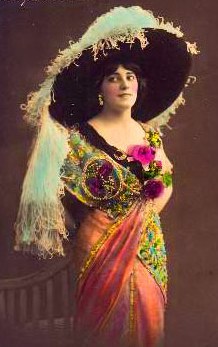 Selling Raquel Meller...
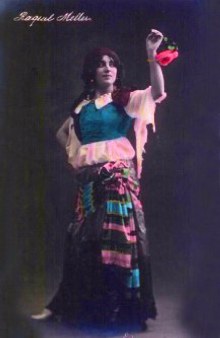 Raquel circa 1911
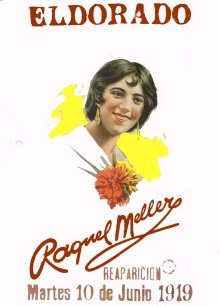 Poster advertising Raquel concerts at the Eldorado Theater (1919)
|
Because of the very nature of the cuplé business not much went on record at that time, least of all if the young newcomer had to "socialize" with the male patrons between shows. Since those activities came with the territory and Raquel needed the cash as much as anybody else, it is safe to assume that she did. However, due to her rebellious nature and strong personality it is also possible that she made sure she was perceived as "different" from the very beginning. She was not, at that point, an extraordinary beauty and did not have a powerful voice, but she obviously had a youthful charm that was hard to resist and was learning fast how to sell a tune on stage.
The rumors persists that at the beginning she was doing more than her expected share of nasty tunes and that her behavior with men was not what was expected of a convent educated young lady. True or not, after those initial months at La Gran Peña, Raquel began moving to better theaters and it was clear she was taking her singing career seriously. It is also around this time that she began a passionate love affair with a German (or Belgian?) sailor whose last name was Moeller. It’s hard to gage how important the relationship was or how long it lasted, but soon after Raquel modified the man’s name to "Meller" and began using it as her own last name. She did it by raw instinct like everything else she did, yet, on the long run, it would prove to be a smart move on her part. After all, stage names with "La Bella" in it had been used to death by dozens of singers while Raquel Meller sounded modern, provocative, legitimate, and commercial.
LAUNCHING RAQUEL MELLER
Raquel made so much noise in Barcelona that soon she was receiving offers from music halls all over Spain. In February 1911 she was booked for the inauguration of the renovated Trianón Palace in Madrid, sharing the bill with three of the most popular singers of the era: Amalia Molina, Pastora Imperio, and a classy new star who called herself "La Goya." Raquel was impressed by La Goya´s elegance and by her resolve to bring respectability to the cuplé genre. Appearing in the same bill with those established artists, helped Raquel’s career greatly just by the association of names.
On September 16, 1911 Raquel opened as a headliner at the Arnau Theater in Barcelona and had a huge success. For many years after, she would give that date as her birthday. "Why not?," she would explain, "Raquel Meller was born on that date at the Arnau." Printed reports confirm that she had every right to be proud of that date since it marked the beginning of her reputation as an outstanding performer. It had nothing to do with the cuplés she sang since, at the Arnau, she sang the usual frivolous repertoire including "La Pulga" (The Flea) always a male crowd pleaser. "La Pulga" is about a troublesome flea invading a lady's night gown and, as was the tradition, Raquel would remove certain pieces of her wardrobe looking for the insect. She had also incorporated into her repertoire a Mexican song she had heard La Goya sing in Madrid. It was called "Ven y Ven" and Raquel’s rendition would soon overtake La Goya’s version in popularity.
Besides doing the expected risqué material, she also managed to include some other tunes which dealt with lost and found love, patriotic themes of land and country, gypsy songs from Andalusia, and a few which added comedy to the act. The word went out that at the Arnau a new kind of cuplé star had been born. The public responded enthusiastically and women began showing up in large numbers at every performance. There was something about Raquel’s delivery, a certain finesse and spirituality, which made even the most raucous cuplé acceptable even to the ladies. La Goya had started a similar trend with her elegant gowns, jewelry and ladylike manners. With Raquel the key was the performance, basically she communicated her feelings to the audience revealing the unequivocal signs of a great actress.
As the cuplé gained in popularity and social acceptance, many legitimate composers, lyricists and poets were inspired to write new material for the stars of the genre. We can safely affirm that between 1910 and 1912 the golden age of the cuplé had formally begun and there was no turning back. Raquel and the other ladies benefited greatly from this when they could choose from superior material the songs that best suited their individual talents and styles. Raquel discovered she had a born knack for finding songs that would suit her both as a singer and story teller.
LEAVING FOOTSTEPS
It was in 1912 when, fresh from her triumph at the Arnau, Raquel was signed by Odeon to record her first sides. You can tell by the titles chosen the kind of material that Meller was asked to record: "Como Se Hace El Amor" (How to Make Love), "La Buena Discipula" (The Good Female Disciple), "La Apache" (The Female Bandit), "Desengaño" (Disenchantment), "La Esclava Mora" (The Moorish Slave Girl ), "La Gitana Hechicera" (The Bewitching Gipsy), etc. She also recorded "El Liberal", an up-tempo novelty tune in which she promotes the newspaper of the same name. It was an instant hit that placed her among the top recording stars of the day and added a whole new dimension to her unstoppable career. Not to mention that, from then on, she could count on Spain's liberal press for plenty of free publicity.
Raquel was maturing rapidly both as an artist and as a woman. Perhaps she hid her lack of formal education behind a temperamental disposition that soon gained her a reputation as an insufferable diva. Actually it was all part of her stubborn nature but again, it worked in her favor. She was creating a public image that distanced her light-years away from her competitors and attracted, not only males and females. to her shows but also the aristocracy, intellectuals, painters, bankers, in short the best of society. By the force of her personality she had made the cuplé an art form everybody could identify with. Of course the movement had been started by La Goya, but Raquel took it and ran with it like a bandit.
|
1914 was another banner year for Raquel Meller. She performed continuously in better theaters and music halls throughout Spain, recorded twice the amount of songs required on her original contract, and the emerging gossip tabloids were full of her coming and goings including some wildly reported romances. She also made it a point to keep up with the competition showing up without warning at the opening nights of other cuplé artists. She was present when Mari Focela debuted a song about a bullfighter who dies in the bullring written for her by José Padilla and lyricists Montesinos and Castellvi. It was called "El Relicario" and to introduce what she hoped would be a big hit, Miss Foncela commissioned a brightly lit stage resembling a bullring with all the colorful pageantry of the real thing. She herself wore a striking multicolor gown covered with a huge white mantilla. The presentation had spectacular written all over it but Miss Foncela’s efforts were rewarded only with polite applause from the audience. Those seated next to Raquel could hear her murmuring: "Interesting...interesting..." without really knowing what she was referring to. That night Raquel made sure she took home a copy of the sheet music for "El Relicario."
A few weeks later, on her debut at El Dorado in Barcelona, Raquel decided to unleash her own version of "El Relicario." She wore an all-black outfit with a black mantilla, almost no make-up and instructed the theater management to give her only a plain black backdrop and a single spotlight pointing at her face. During her rendition of "El Relicario", the public seem hypnotized. After finishing the song by sobbing the last verse instead of singing it, there was pandemonium in the audience. With this performance Raquel Meller had achieved immortality as a singer, an accomplishment that was aptly corroborated the following year with another Padilla-Montesinos cuplé about a young girl peddling violets on the streets of Madrid. It was "La Violetera" a tune commissioned by Carmen Flores but promptly discarded when her audiences reacted coldly towards it. Both songs were immediately recorded by Raquel and the discs sold like hot cakes as soon as released. The music sheets featuring striking photographs of Meller on the covers also sold by the thousands making singer and composers quite wealthy.
By this time, Raquel was attracting attention not only for her musical career but also for her personal life which was, like "El Relicario", full of drama and suspense. Stories circulated about her squabbles with other performers to defend what she saw as her "right to exclusivity" on certain songs. In one such occurrence, she interrupted another singer's performance of "La Violetera" by climbing on stage and knocking the violets out of the artist's hand while screaming: "You are stealing from me!"
Raquel’s temperament would flare up at anything she considered a provocation. In 1918 during a successful run in Madrid, she received a personal invitation from His Highness King Alfonso XIII to perform in the Royal Palace. Her reaction was quite rude. "There is the same distance from the palace to the theater than from the theater to the palace. If the King wants to see me perform he should come to the theater. " Days later King Alfonso took the challenge by materializing at the theater with Queen Victoria in tow. Raquel was sincerely touched by their presence and asked the Royal couple to forgive her rudeness. She dedicated the night's performance to them and from then on became a loyal subject of the monarchy.
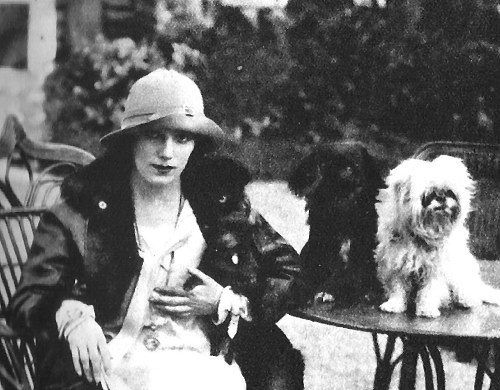 Raquel posing proudly with her beloved pets.
TRUE LOVE
There were also stories of her ruthlessness when dealing with would-be suitors. Painter Joaquín Sorolla had fallen in love with her and was trying to win her attention by drawing adoring sketches of the diva and leaving them with his signature on her dressing room at whatever theater she was performing. Mortified by the painter's insistence, Raquel had it all taken away as garbage, oblivious to the fact that she was trashing away a potential fortune in art. People were baffled by her attitude since few knew that she was secretly in love with 20 years old Joaquín Sorolla Jr., the only male son of the painter. Nobody can tell if she was ever able to lure the young man occasionally into her bedroom but the son never considered a serious commitment with the singer unleashing a dark cloud of depression on Raquel. She tearfully sang about her frustrations with "Mala Entraña",
a cuplé which became another one of her signature songs:
|
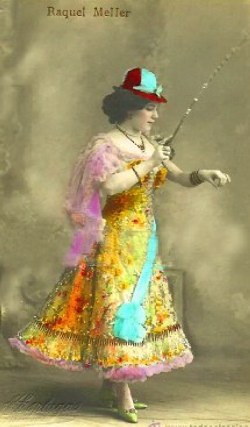 Raquel Meller with cane and hook...fishing for a man?
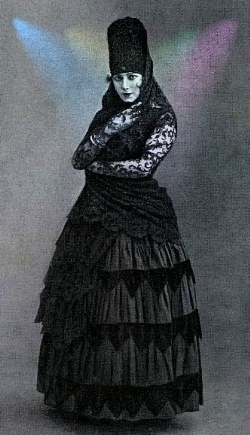 Raquel makes a statement with
"El Relicario"
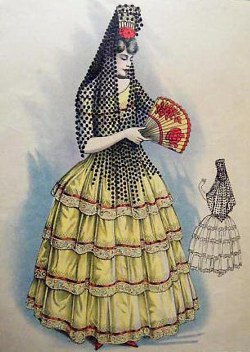 Raquel Meller styles as printed on fashion magazines.
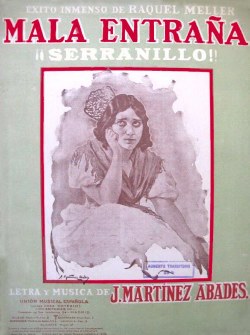 Sheet music for her heartfelt hit.
|
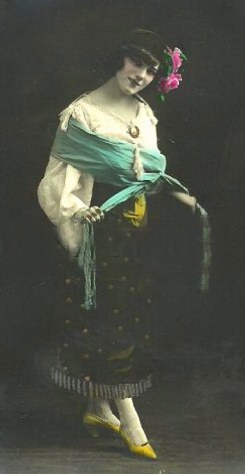 A romantic pose by a beautiful Raquel
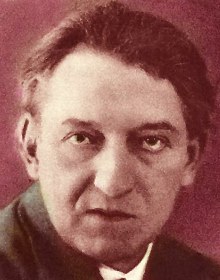 Enrique Gómez Carrillo
the man she loved...
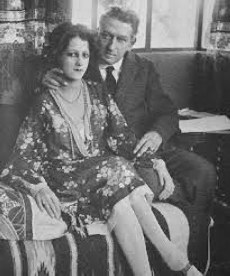 Raquel and Enrique during their extended honeymoon.
|
By 1919 Raquel had reached superstardom status in Spain and was ready to project herself internationally. Paris was then considered the show business capital of the world, and that year she made her debut at the Olympia Theater without speaking one word of French. It didn't matter; her body movements were so expressive, her face so in tune with each cuplé and her gestures so all-embracing that in less than an hour she had the French eating out of her hand. Raquel Meller was now a household name in France and, by default, all Europe. Back in Spain she found her agenda full of professional commitments starting with the leading role in the film "Arlequines de Oro y Seda" as well as more recordings for Odeon. But on a personal level, the most important event of the year was Raquel’s liaison with Guatemalan born author Enrique Gómez Carrillo.
A notable literary talent along with a carefree life style made Gómez Carrillo one of the most representative characters of la belle époque. They had been friends since 1917, but now it became more intimate.
It was a head-on collision of two very strong personalities. He had a tremendous reputation as a journalist, all around intellectual, diplomat and chronic playboy. She demanded his undivided attention and was used to having the last word on everything. He refused to renounce his public Casanova image for domestic bliss and was used to being the main attraction wherever he went.
On September 7, 1919, the unlikely couple tied the knot in Biarritz and embarked on a lengthy honeymoon which took advantage of Raquel’s first international concert tour. With stops in Buenos Aires, a triumphal two months in London and a return to Paris, Raquel was received everywhere with enthusiastic fervor and was granted the best reviews of her career, especially in England where even King Edward had warm words for her performances. During this time one of her biggest dreams came true when she and her husband where received in a private audience by H. H. Pope Pius XI in Rome.
The first year of marriage had gone reasonably well, but as time went on, it became apparent that trouble was brewing for the famous couple. They adopted a girl in Buenos Aires whom they named Elena, hoping for a uniting factor in the relationship, but neither had parental vocation, and the addition to the family backfired. Soon came open warfare though it's to their credit that they never discussed publicly the details of the disagreements, but by February of 1922 they had filed for a divorce. It was a tough decision for both since they seemed to be sincerely in love, but their personalities were totally incompatible. For Raquel the separation also meant that the respect she had acquired from the intellectual establishment as Mrs. Gómez Carrillo was now in jeopardy. She didn't need to worry though. Her image and her songs were already too embedded in people's hearts everywhere.
THE GLORY
Actually her popularity grew to unsuspected heights in the years that followed. Part of that development came from her successful involvement with the French film industry. After turning out a respectable performance in the 1923 Henry Roussel film "Les opprimés" (The Oppressed) she broke box office records with "Violettes impériales" (Imperial Violets) directed also by Rousell and released in 1924. She was now perceived as credible film actress and international movie queen.
About this time many legends involving Raquel began circulating. One of the most outrageously untrue was the one that blamed her for Mata Hari´s death by firing squad. According to this fictitious tale it was Raquel who turned over Mata Hari to French authorities since the dancer-spy was flirting with Gómez Carrillo. Just by checking the dates it becomes obvious that the story is fraudulent but surprisingly it followed Raquel throughout her life and it is still repeated in certain quarters. These legends only highlight the impact that Raquel Meller had on the culture of her time and the greatness of her achievements.
|
Raquel was no fool and realized this was her time to make some serious money in merchandising. Besides the usual selling of her image for photographs and post cards she began endorsing products, and soon both the media and the stores were flooding with Raquel Meller products. Everything from Meller dolls to Meller Lalique crystal including song books, fans, chocolates, cigarette paper, wine, beauty creams and even Valencia oranges. With the consequent avalanche of currency, Raquel launched a lavish lifestyle for herself and invested heavily in real estate buying a home in Barcelona, a palace in Versailles and a summer villa in Villefranche-sur-Mere in the magnificent Cote D'Azure. She furnished and decorated her dwellings with invaluable original art and antiques, all of it adding to her social status and respectability.
|
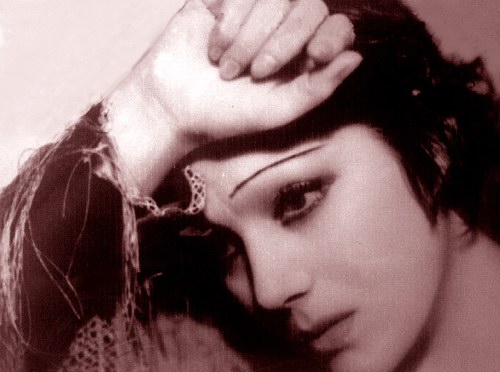 The divine Raquel...
|
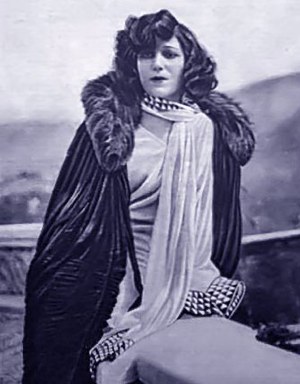 |
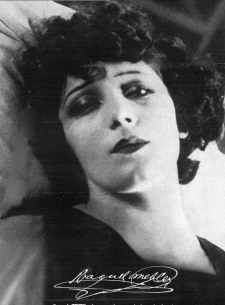 Beautiful and ready for her close up
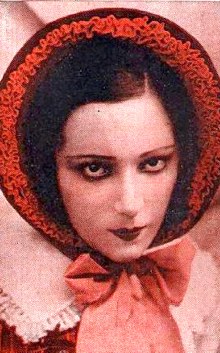 As Violet in "Imperial Violets"
a box office sensation.
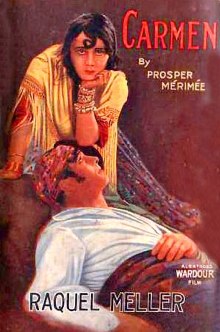 Raquel as a remorseful "Carmen"
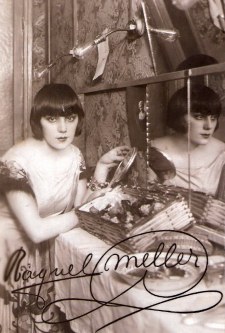 A striking Raquel in dressing room
|
This new prestige was taken very seriously by the artist who became more protective than ever of her public image. In interviews she avoided all references to her beginnings opting for the image of a religiously devout lady with the highest moral principles. If anyone begged to differ, he or she would find themselves the recipients of Raquel’s bad temper which could be quite brutal. "They accuse me of having a bad temper but it is not my fault," she explained. "I am usually very civil if they treat me with politeness, but if they are rude, I am forced to react the same way." Being "rude" meant that certain subjects could never be discussed such as her miserable childhood or details of her path to fame. Even "La Pulga" became a censored topic. However, the fact that she refused to discuss her origins did not mean that Raquel ever forgot her family especially her mother and sister. She always took good care of them even if they lived far apart. Actually her sister, who performed under the name Tina Meller, always lived in the shadow of her famous sibling and had small parts in some of her films. Raquel was also extremely generous with other relatives, friends and even strangers who approached her for a handout.
On the other hand, behaving like a grand dame in the frivolous world of entertainment resulted in constant clashes with loving suitors, promoters, theater managers, the media and even other artists. Besides being violently vindictive towards competitors who dared sing "her songs" she had no tolerance of anybody who attempted to satirize or parody her image. An altercation with Encarnación López, a.k.a. "La Argentinita" has gone down in history. This famous singer-dancer usually included in her routine parodies of other popular stars including Raquel Meller. One night, "La Argentinita" was performing and didn't notice that Raquel was backstage watching her every move. Half way through the show she proceeded with her Meller imitation. All of the sudden Raquel broke on stage, slapped her face furiously while hollering, "this is from me to you!" and disappeared.
Another well known dispute arose during the filming of her next vehicle "Carmen" (1926), based on the novel by Prosper Mérimée. Director Jacques Feyder thought it was an inspired decision to cast the temperamental Raquel as Carmen, and Raquel was equally excited about playing the celebrated Spanish character. Of course she had never read the book but soon realized she was playing not only a tempestuous gypsy but also a woman of dubious morals. During the shooting of exteriors in Ronda, she began demanding certain changes to the script but was always turned down with the excuse that "we can not alter what Monsieur Mérimée wrote." Always used to having her own way, Raquel exploded one day screaming, "I am sick of this Mérimée person! Get him on the telephone immediately and I will talk to him. He'll have to see it my way!" Feyder and the crew cracked up since Prosper Mérimée had been dead for half a century. In spite of all the hassles and a timid performance by the star, "Carmen" was a big hit all over the world and remains a French film classic.
ASSAULTING THE UNKNOWN
Raquel had received several offers to sing in the United States but she had been so busy in Europe that she just couldn't get away. Also in her free time she preferred holding court at one of her residences, especially at the Versailles chateau, where she received her guests surrounded by antiques and art work by Matisse, Rodin, Carrière, Renoir, Toulouse-Lautrec, Picasso and even Sorolla. One of her favorite pieces was a creme colored piano hand-painted with colorful flowers, whose previous owner had been none other than Mozart himself. In "queen of the castle mode" she loved to be photographed next to this extraordinary and valuable instrument. She had come a long way from her days as a seamstress and as a struggling "cupletista" virtually singing for her meals.
In 1926 American promoter Ray Goetz made Raquel an offer she couldn't refuse. $100,000 dollars for sixteen performances at the Empire Theater in New York City and the opportunity of making much more touring major cities in the United States. Before signing on the dotted line, Raquel demanded all kinds of reasonable and unreasonable perks for the trip and for her stay in America. She wanted deluxe accommodations in the plush ocean liner SS Leviathan for the transatlantic voyage. Also the most luxurious hotels for her and her entourage which included a wardrobe mistress, a secretary and three chefs to prepare her meals, one for French, one for Spanish and one for Chinese delicacies. On land she expected two railroad cars for herself and company to travel on private tracks and security guards to accompany her at all public outings. Mr. Goetz agreed to all her demands knowing that there was great expectation in the U.S. to see the woman publicized as "the soul who sings" and that he could charge $25.00 dollars admission, an unheard of ticket price at that time.
|
